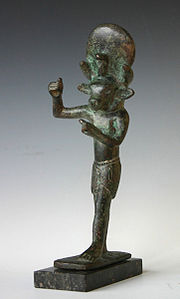
Mnewer
Encyclopedia

Egyptian mythology
Ancient Egyptian religion was a complex system of polytheistic beliefs and rituals which were an integral part of ancient Egyptian society. It centered on the Egyptians' interaction with a multitude of deities who were believed to be present in, and in control of, the forces and elements of nature...
, Mnevis (also written Mer-wer) was an aspect of the chief god in the region of Heliopolis
Heliopolis (ancient)
Heliopolis was one of the oldest cities of ancient Egypt, the capital of the 13th Lower Egyptian nome that was located five miles east of the Nile to the north of the apex of the Nile Delta...
, Atum-Ra
Ra
Ra is the ancient Egyptian sun god. By the Fifth Dynasty he had become a major deity in ancient Egyptian religion, identified primarily with the mid-day sun...
. The origin and meaning of its name is currently unknown.
Mnevis was identified as being a living bull. This may be a vestige of the sacrifice of kings after a period of reign, who were seen as the sons of Bat or Hathor
Hathor
Hathor , is an Ancient Egyptian goddess who personified the principles of love, beauty, music, motherhood and joy. She was one of the most important and popular deities throughout the history of Ancient Egypt...
, the ancient cow deity of the early solar cults. Thus, seen as a symbol of the later sun god, Ra, the Mnevis was often depicted, in art
Art
Art is the product or process of deliberately arranging items in a way that influences and affects one or more of the senses, emotions, and intellect....
, with the solar disc of their mother, Hathor between its horns.
A suitable bull was selected from the area, said to be the living Mnevis bull, and was taken to a special temple, where it was worshipped and its movement used as an oracle
Oracle
In Classical Antiquity, an oracle was a person or agency considered to be a source of wise counsel or prophetic predictions or precognition of the future, inspired by the gods. As such it is a form of divination....
. Since the fertile soil of the Nile was so black that the word for black
Black (hieroglyphic 'km')
The Egyptian hieroglyph for "black" in Gardiner's sign list is numbered I6. Its phonetic value is . The Wörterbuch der Aegyptischen Sprache- lists no less than 24 different terms of km indicating 'black' such as black stone, metal, wood, hair, eyes, animals and people.The most common explanation...
(Khem) became the Egyptian
Egyptian language
Egyptian is the oldest known indigenous language of Egypt and a branch of the Afroasiatic language family. Written records of the Egyptian language have been dated from about 3400 BC, making it one of the oldest recorded languages known. Egyptian was spoken until the late 17th century AD in the...
word for Egypt, and bulls in this region had a tendency to black colouring, the bull selected to be the Mnevis was traditionally completely black, thus being referred to as Kemwer, meaning great black (one). When a completely black bull could not be found, they chose one that was completely white, in contrast.
Eventually, it became identified as another form of the increasingly more popular Apis
Apis (Egyptian mythology)
In Egyptian mythology, Apis or Hapis , was a bull-deity worshipped in the Memphis region.According to Manetho, his worship was instituted by Kaiechos of the Second Dynasty. Hape is named on very early monuments, but little is known of the divine animal before the New Kingdom...
, which had become considered an aspect of Osiris
Osiris
Osiris is an Egyptian god, usually identified as the god of the afterlife, the underworld and the dead. He is classically depicted as a green-skinned man with a pharaoh's beard, partially mummy-wrapped at the legs, wearing a distinctive crown with two large ostrich feathers at either side, and...
when his cult became prominent.
See also
- ApisApis (Egyptian mythology)In Egyptian mythology, Apis or Hapis , was a bull-deity worshipped in the Memphis region.According to Manetho, his worship was instituted by Kaiechos of the Second Dynasty. Hape is named on very early monuments, but little is known of the divine animal before the New Kingdom...
- Bukhis
- Bull (mythology)Bull (mythology)The worship of the Sacred Bull throughout the ancient world is most familiar to the Western world in the biblical episode of the idol of the Golden Calf. The Golden Calf after being made by the Hebrew people in the wilderness of Sinai, were rejected and destroyed by Moses and his tribe after his...

